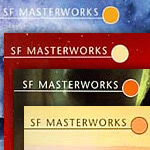When I begin to describe John Houlihan’s The Seraph Chronicles Volume One: Tales of the White Witchman, the combination of themes will seem bizarre to most. I went through precisely this same train of thought and started reading The Seraph Chronicles with a sceptical mind but came out converted; proven previously cynical.
THE TRELLBORG MONSTROSITIES (Book One of The Seraph Chronicles)
The simple breakdown of this three-book-volume is made up of Nazi agendas, gods, supernatural occurrences, monsters and historical inspiration. John Houlihan’s first book The Trellborg Monstrosities, of The Seraph Chronicles Volume One: Tales of the White Witchman, threw me headlong into this uniquely varied genre. A major plus of this book I think; there is no faffing about with getting stuck in, I was pitched into the suspense and action from the first page and it keeps up the pace as it goes.
The plot follows The Chronicles’ namesake, the eclectic character Seraph – the White Witchman himself – and the more normalised Major Powell, plus a few of his men from a mysteriously named “the Section”. Together they oppose the SS and other Nazi associated groups. These Nazi groups are concerned with getting their hands on an artefact that will make their cause stronger and ultimately invincible. In the pursuit for this artefact, plans go awry (naturally) and we see the effects this has on the mind of one powerful man Ludwig von Obertorff, the lives of the local villagers and the company of men from “the Section”.
When I began to read The Trellborg Monstrosities I felt I could not connect with the dialogue. When I read a book I go into a nice little bubble of just myself and the story, oblivious to anything else around. When starting to read The Chronicles, I found I could not quite get into my bubble at first. I also thought on the first read that Major Powell – who is our guide and the point of view throughout the book – was conflicted on his feelings about the whole supernatural aspect of the plot. The abrupt changes between disbelief and acceptance in his character during the exposure to supernatural occurrences was just a touch odd for me. Although, perhaps that is just my sceptical side rearing its head there, for when I had finished The Trellborg Monstrosities I re-read it, particularly focusing on the beginning of the book to see if I still had these reservations concerning the dialogue. I actually found they were not as noticeable. Paradoxically to my first impressions of the dialogue, the writing style and language was beautiful to me from the outset, a reader’s dream. I could imagine everything Houlihan described in complete clarity. Setting and action enticed me to read paragraphs multiple times, just to soak up the atmosphere that Houlihan had created.
I believe that my momentary reservations about the dialogue stemmed from my reluctance to immerse myself unconditionally in such an unfamiliar topic. I have learned my lesson! Once I understood the pace of the book and got into the mind set of undead Nazi soldiers allied with beasts of ice being the general theme, I realised that perhaps what I perceived as a blasé attitude in Major Powell could actually be seen as an author-intended coping characteristic. I particularly enjoyed Seraph’s character. He made me think of a science fiction Sherlock Holmes character; a cut above the rest in intelligence and with a flair for dramatic deliverance, with Major Powell serving as a characterful Watson.
As we are following the The Chronicles’ namesake, Seraph, it is only fair to mention that despite reading my way through the three books, his character remains cocooned in a shroud of mystery. I cannot say that I felt I got to know his character any better as the series progressed. Although, I think if we got to know him too well he would lose the mysterious quality that forms the basis of his character. After all, the mystery of something is what pushes you on to the discovery is it not?
THE CRYSTAL VOID (Book Two of The Seraph Chronicles)
The second book in The Seraph Chronicles, The Crystal Void starts with a dialogue, almost a – here comes an over-used phrase – continuous stream of consciousness. If you studied an English related subject at any point you will now be cringing to see me use this phrase in a sentence of my own free will, under no exam conditions. Despite the over-used associations this term has with literature analysis, I still like it. For times like these, there is no better description. What with my previous comments about the dialogue you may fairly assume I found the same issue here too. The opposite is in fact true, I could not get enough of this man Gaston d’Bois and his story. I was instantly hooked by this book.
Despite the name of this series being a bit of a giveaway in hindsight (The Seraph Chronicles) it took me by surprise when Seraph appeared as the fateful rescuer. I was so captured by possibilities for the fate of Mademoiselle Odette d’Hiver and pondering on how Lieutenant Gaston d’Bois would save her from the clutches of Marquis Phillipe de Figueira da Foz (what fantastic names), that I forgot that I was waiting for Seraph’s appearance at all. That was how gripping I found the story line.
I was so enjoying the story line of the second book, that to an extent I didn’t want Seraph to come and eclipse any importance that the current characters may hold. I felt this happened a little between Seraph and Major Powell in The Trellborg Monstrosities. The only reason why it was noticeable to me is because our point of view comes from the secondary characters in The Chronicles; the secondary characters in each of the three books being Major Powell, Gaston d’Bois and the Kommandeur. I call them secondary characters only in terms of the primary character being Seraph. Once I thought about it and understood the importance of Seraph being our true focal character even if he is not our voice, it was a much clearer journey. In fact, I began to see Seraph’s actions as having a mothering quality towards our secondary characters and so once again the Sherlock and Watson duo comparisons were at full whack.
In short, this second book in The Chronicles was my favourite. Everything about The Crystal Void was a credit to Houlihan.
TOMB OF THE AEONS (Book Three of The Seraph Chronicles)
And so we come to the third and final book in The Seraph Chronicles Volume One: Tales of the White Witchman. The rules of the series still apply, Seraph saves the day and we follow a lesser mortal through various chasms of hell. In this case, the mortal in question I simply knew as Kommandeur Siegfried. We are introduced to the Kommandeur during his active service and we can see from his actions towards the enemy that he is not afraid of breaking the rules to get results. I think this character was a little more hardened and capable in his personality than the other two. Well, he was at least far more sensible about diving headfirst in to a tomb steadily piling up with ever increasing amounts of bodies. Despite my fondness for Lieutenant Gaston d’Bois’ quirky manner I did appreciate this display of realistic humanity in the Kommandeur.
This book had a very cult-like feeling. All books had elements of cult-like behaviour but Tomb of the Aeons had the robed figures, blood sacrifice and the calling-up-of-a-monster-from-the-deep vibe. Very fitting with how Seraph’s magic appears to develop over the series. I am still not sure how to peg Seraph’s magic, along the lines of the mystery that comes with Seraph. If I found out the secrets behind the sorcerer I think it would spoil the effect. Some may disagree.
So, summing up the topics in this book: cults, snake men, soldiers, monsters and Seraph. Also, there is a kitten, Little Hans, involved in this book. An instant winning quality if ever there was one. I was sold.
ON THE WHOLE…
If consistency in plot and character profiles are a must in your reading material list then I really recommend. If you prefer to be kept guessing in plot lines then perhaps not. The books are reassuring in their consistency of deliverance. I did find the second book The Crystal Void was my favourite, the nature of d’Bois’ character I enjoyed. He is quirky and intriguing and the style of writing in the book matches the character’s quirky nature.
If you have a liking for the first book, then I would say that you are guaranteed to enjoy them all. After a little perseverance of faith and understanding of the topics I enjoyed them very much. I hope and assume that there will be a The Seraph Chronicles Volume Two, in which case I am looking forward to how the White Witchman and his companions progress in some structural twists and turns and of course, a return of the Sherlock/Watson qualities!
Happy reading…


